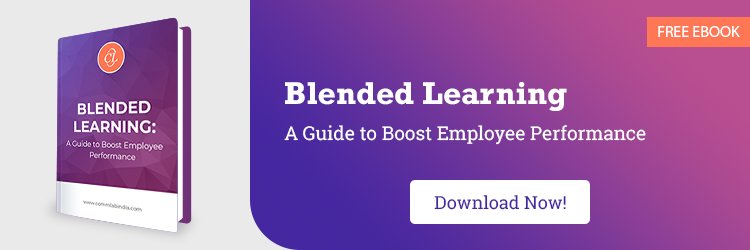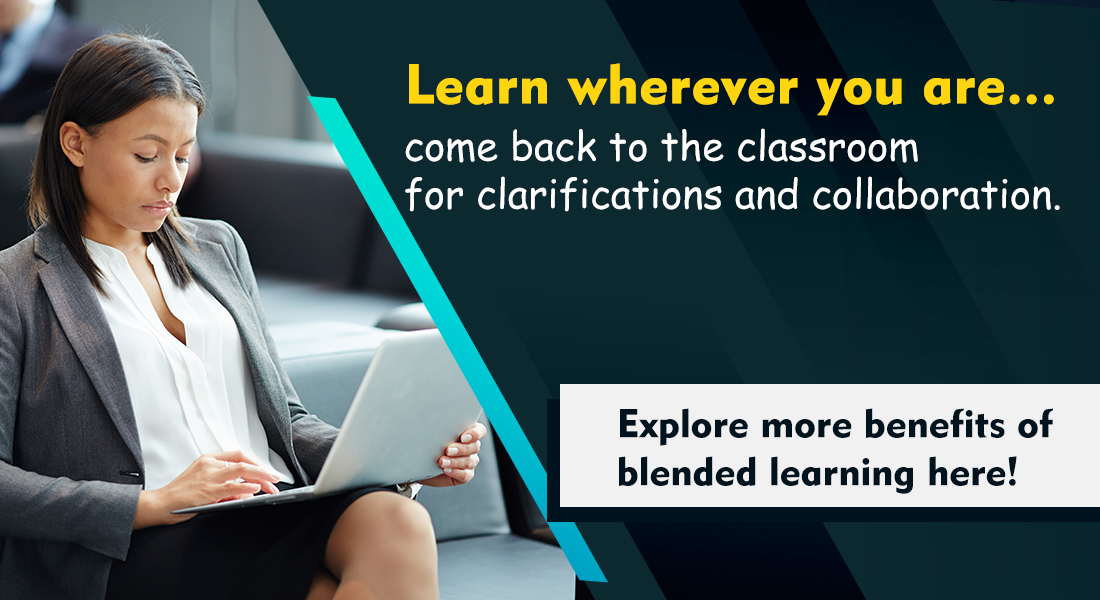Blended learning combines the personalized interaction of traditional face-to-face classroom training with the flexibility and convenience of online training. It leverages technology to supplement classroom training and improve learning, and leads to enhanced job performance through practice and the application of face-to-face learning.
Learning Formats in a Blend
这种混合或混合学习策略结合了:
- 讲师主导的培训(ILT) - 基于课堂或虚拟讲师主导的培训(VILT)与讲师指导,教练,互动和吸引学习者。
- 电子学习 - 基于学习需求和表现成果的正式结构化在线学习模块,可作为独立课程或课程课程。
- 即时培训 - 移动学习,数字资源(模拟,动画,测验,游戏,信息图表)
- Performance Support — How-to guides, videos, job-aids, mobile applications
- Social Learning — Discussion boards, online forums
Download the beginner’s guide to VILT.
Most of us understand that blended learning is a combination of in-person and online training programs. However, not all of us know about the several delivery strategies in blended learning. The Bookend blended learning model is one of them, and we’ll look at what this model of blended learning delivery offers in this SlideShare.
Bookend混合学习模型是一种三相策略,它使用在线培训作为面对面教学的书挡。根据尼克·范·达姆(Nick van Dam)的说法电子学习现场手册, starts and ends with online instruction, with a brief classroom or virtual classroom session sandwiched in between.

The main advantage of the Bookend blended learning model is that it reduces employees’ time away from work by cutting down on classroom or face-to-face training.
3 Phases of the Bookend Blended Learning Model
Phase 1: Planning and Preparing to Gain Basic Knowledge
书架混合学习模型中第一阶段的目标是获取和评估知识。它涉及:
- 通过自学电子学习模块
- Allowing learners to:
- Browse articles related to the training content
- 进行在线自我评估来测试其当前或先验知识
This phase also helps training managers decide on the need for additional teaching or explanation in the next phase of training.
Phase 2: Interacting and Focusing on Practicing Skills
书区模型中第二阶段的重点是实践和团队合作。此阶段是在教师的帮助下进行的 - 要么作为面对面的课堂培训,要么与讲师进行虚拟会议。书峰模型的好处是,它为学习者提供了与同龄人和讲师互动和互动的机会(而不是像异步的自定进度学习那样被隔离)。
Classroom training is primarily focused on dealing with complex topics and practicing skills. Group discussions and role plays can also be included in the classroom training.
Phase 3: Applying Learning and Providing Performance Support
The learning goal of the third phase of the Bookend model is the application of knowledge that learners have gained in the first two phases. This is offered as performance support through microlearning or digital assets. This aspect of the learning process is frequently overlooked in training programs.

Employees go through training programs, and whether they are able to apply the knowledge gained is up for debate. The final phase in the Bookend model takes care of the application part, closing the cycle of learning effectively.
Providing learners effective performance support enables them to perform tasks at the workplace efficiently. Learners can, for example, view a video that quickly shows how to complete a task or go through an infographic that lists the steps of a process. They can also participate in discussion boards to learn more from subject matter experts.
Parting Thoughts
当涉及到最少的课堂时间中,有效地利用在线培训资源以及加速知识从培训到工作的转移时,您不能比BookEnd Blogended Blendend学习模型做得更好。
Don’t forget to download our eBook on ‘Blended Learning’ if you want to discover how to utilize blended learning to increase employee performance quickly. This eBook is aimed for those who want to use technology to improve employee performance and reduce the time it takes to prepare them for their jobs. It provides practical guidance on how to choose the best training strategy for a given learning need while minimizing duplication of efforts and resources. It also provides a solid framework for building a company’s ideal blended learning strategy.





![Blended Learning for a Holistic Learning Experience [Infographic]](http://www.vine9.com/wp-content/uploads/2019/11/blended-learning-holistic-learning-experience-infographic-main.jpg)
